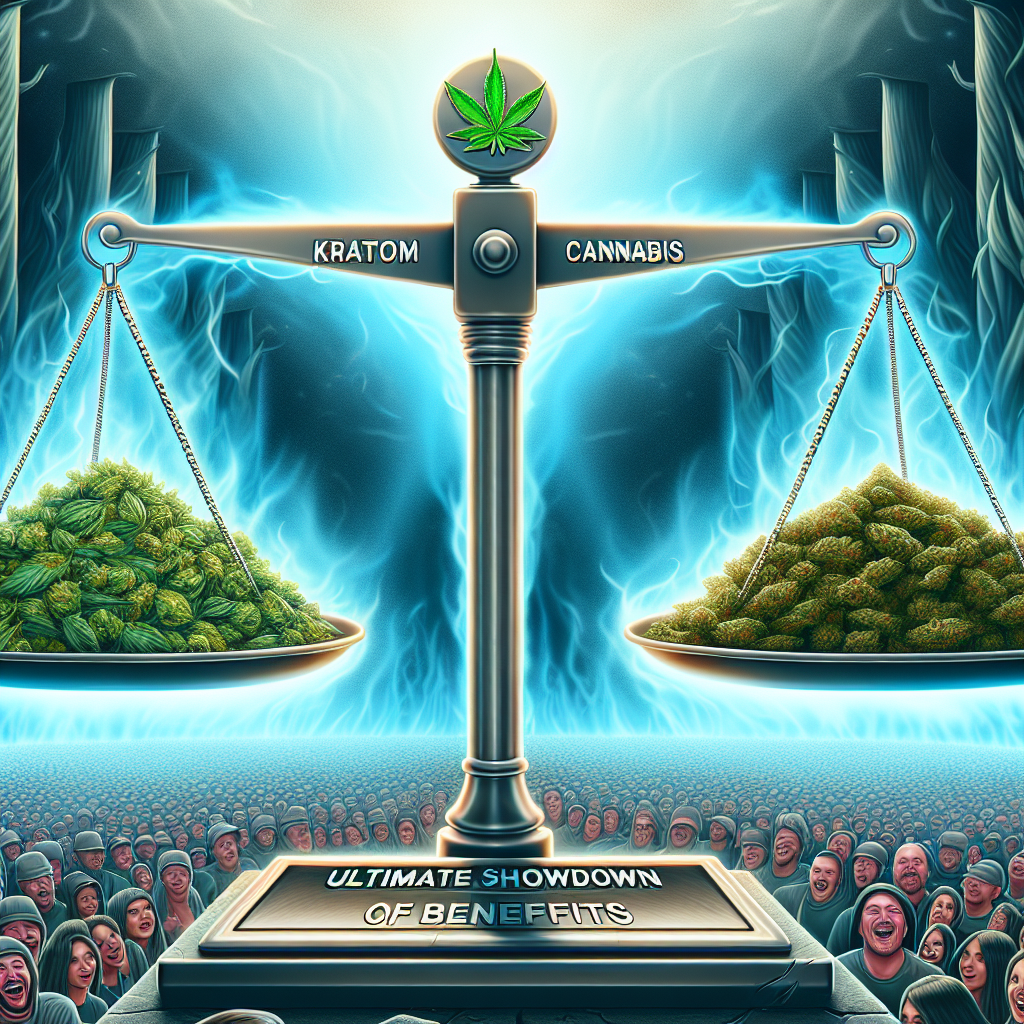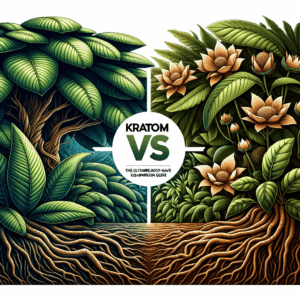
Kratom vs Cannabis: Ultimate Showdown of Benefits
- Understanding Kratom and Cannabis
- Comparing Effects
- Pain Relief
- Mood Enhancement
- Anxiety and Stress Relief
- Potential Risks and Side Effects
- Risks of Kratom
- Risks of Cannabis
- Legal Status
- Methods of Consumption
- Consuming Kratom
- Consuming Cannabis
- Cost Analysis
- Choosing the Right Option for You
- Consultation with Professionals
- Frequently Asked Questions
- Conclusion
- References
Understanding Kratom and Cannabis

Kratom and cannabis have gained immense popularity in recent years. As people seek natural alternatives for pain relief, mood enhancement, and relaxation, these two plants often take center stage. While both substances originate from nature, they belong to different botanical families and have distinct effects on the body. This article explores the benefits, risks, and uses of kratom and cannabis, helping you understand how they can meet your health and wellness needs.
What is Kratom?
Kratom, or Mitragyna speciosa, is a tropical tree native to Southeast Asia. Its leaves have been used for centuries due to their medicinal properties. Traditionally, Southeast Asian communities chew kratom leaves for pain relief and to boost energy. The leaves contain compounds like mitragynine and 7-hydroxymitragynine, which interact with opioid receptors in the brain, providing pain relief similar to that of opioids, but with fewer side effects.
People often use kratom for various purposes. Some consume kratom to increase alertness and productivity, while others seek it out for anxiety and depression relief. Many users also report it helps with withdrawal symptoms from opioids.
What is Cannabis?
Cannabis, also known as marijuana or hemp, has been utilized for thousands of years for its psychoactive and therapeutic properties. This plant features various compounds called cannabinoids, the most well-known of which are tetrahydrocannabinol (THC) and cannabidiol (CBD). THC is the primary psychoactive component, causing the “high” sensation that many associate with cannabis use. In contrast, CBD is non-psychoactive and is often used for pain relief, anxiety reduction, and various other health benefits.
Cannabis can be consumed in multiple forms: smoking, vaping, edibles, oils, and capsules. Each method provides different effects and durations. Understanding how to use cannabis effectively is crucial for those seeking its benefits.
Comparing Effects
Pain Relief
Both kratom and cannabis provide pain relief, but they do so in different ways. Kratom works by binding to opioid receptors, alleviating pain while promoting feelings of euphoria and relaxation. Users often report significant relief from chronic pain conditions, making it an appealing alternative to traditional painkillers.
On the other hand, cannabis offers pain relief through its cannabinoids. THC can reduce inflammation and stimulate appetite, while CBD helps relieve pain without causing a high. Many users find that a balanced strain containing both THC and CBD efficiently addresses their pain and helps promote overall wellness.
Mood Enhancement
Kratom has stimulating properties in lower doses, leading many to feel energized and focused. However, higher doses may produce sedative effects, helping users manage anxiety or depression. Some people find this duality appealing, as they can adjust their dosage to meet their current needs.
Cannabis compounds also impact mood, but they may not provide as much flexibility as kratom. While some strains are energizing and uplifting, others are calming and relaxing. Users should consider the strain and THC/CBD content when looking for mood enhancement, as individual reactions can vary.
Anxiety and Stress Relief
Both kratom and cannabis offer potential benefits for anxiety relief. Kratom’s sedative effects help some individuals manage anxiety, providing a sense of calm without the histamine response some experience with other medications. However, not everyone responds the same way, and higher doses may provoke anxiety in some users.
Cannabis is widely recognized for its stress-relieving properties. Many people use CBD-rich strains to help manage anxiety without feeling paranoid or high. However, THC can exacerbate anxiety in some individuals, so it’s essential to find the right balance that works for you.
Potential Risks and Side Effects
Risks of Kratom
Despite its benefits, kratom comes with risks that users should consider. Firstly, because kratom can have opioid-like effects, there is a risk of dependence with prolonged use. Some individuals may develop a tolerance, leading them to consume larger amounts, increasing their risk of withdrawal symptoms.
Secondly, kratom can interact with other medications. Some individuals report nausea, vomiting, or digestive issues when first using kratom. It’s crucial to start with a low dose to see how your body reacts.
Risks of Cannabis
Cannabis also has potential downsides. Its psychoactive component, THC, can lead to cognitive impairment, particularly in inexperienced users or high doses. Short-term side effects include impaired memory and coordination, which may not be suitable for everyone.
Moreover, regular cannabis use, especially among young people, may lead to an increased risk of mental health issues. Research suggests that heavy use can contribute to anxiety, paranoia, or depression. Users should practice moderation and consult healthcare providers when needed.
Legal Status
The legal status of kratom and cannabis varies greatly from one region to another. In the United States, cannabis is legal for recreational or medical use in many states, while kratom remains largely legal but unregulated. Some states have imposed restrictions on kratom sales and use.
Understanding the laws in your area is crucial for both medicinal users and recreational users. Regulations are continuously changing, so staying updated can help you avoid legal repercussions.
Methods of Consumption
Consuming Kratom
Kratom can be consumed in various ways. Here are some popular methods:
1. Powder: The most common form, often mixed with water or juice.
2. Capsules: Easy-to-take option for precise dosing.
3. Tea: Brewing kratom leaves or powder for a soothing beverage.
4. Extracts: Concentrated forms, usually more potent.
Each method offers different experiences depending on how quickly and effectively the compounds interact with your body.
Consuming Cannabis
Cannabis offers a variety of consumption methods, including:
1. Smoking: Quick effects, but may irritate the lungs.
2. Vaping: A cleaner alternative to smoking, offering similar rapid effects.
3. Edibles: Longer-lasting effects as the body metabolizes the cannabinoids.
4. Tinctures and Oils: Easy to dose, often used for therapeutic purposes.
5. Topicals: Creams or balms applied to the skin for localized relief.
Choosing the right method depends on your personal preferences and desired effects.
Cost Analysis
Understanding the cost of both kratom and cannabis can help you make an informed decision. Here’s a quick comparison:
| Item | Average Cost | Notes |
|——————|—————–|———————————–|
| Kratom (1 oz) | $10 – $20 | Price varies by strain and seller |
| Cannabis (1 oz) | $200 – $350 | Pricing fluctuates by state and quality |
| Kratom Capsules | $30 – $60 per 100 | Usually more expensive than powder but convenient |
| Cannabis Edibles | $20 – $50 per package | Varies widely based on dosage and type |
When budgeting, consider both initial costs and how often you plan to use these substances.
Choosing the Right Option for You
Deciding between kratom and cannabis depends on your specific needs. If you seek energy and pain relief without a significant high, kratom may be suitable. Conversely, if you’re looking for mood enhancement, stress relief, or relaxation, cannabis could be a better fit.
It helps to reflect on your health goals and what you hope to achieve. Keep in mind that individual responses to both substances will vary, so trial and evaluation could lead to the best personal experience.
Consultation with Professionals
Regardless of your choice, consulting a healthcare professional may provide crucial insights and safety tips. They can offer personalized advice tailored to your health needs, medication considerations, and lifestyle. This step becomes especially important if you plan to mix kratom or cannabis with other medications.
Frequently Asked Questions
1. What is the primary difference between kratom and cannabis?
Kratom is a tropical tree with stimulant and sedative properties, while cannabis is a plant known for its psychoactive and medicinal effects primarily due to THC and CBD.
2. Can I use kratom and cannabis together?
Combining them is not advised without professional guidance. Both can affect your mental state, and their interactions are not thoroughly studied.
3. Are there any legal restrictions on kratom?
Yes, the legality of kratom varies by state and region, with some places imposing outright bans.
4. How do I determine the right dosage for kratom?
Start with a low dose and gradually increase it based on your body’s response and personal needs. Consulting a professional can also help.
5. Does cannabis make everyone feel high?
Not necessarily. It depends on the cannabinoid profile of the strain. CBD-dominant strains typically do not cause a high.
6. How long do the effects of kratom last?
Effects can last anywhere from 2 to 5 hours, depending on the dose and individual metabolism.
7. Is cannabis safe for everyone?
No, particularly for those with a history of mental health issues or in younger individuals, as it may exacerbate certain conditions.
8. Can kratom lead to addiction?
Yes, using kratom regularly may lead to dependence. It’s essential to use it responsibly and be aware of the potential risks.
9. What are the common side effects of kratom?
Nausea, constipation, dizziness, and in some cases, anxiety or mood changes may occur with kratom use.
10. Is it possible to test for kratom or cannabis in drug screenings?
Cannabis is commonly tested in drug screenings, while kratom is less likely to be included but may be tested in specific circumstances.
Conclusion
Kratom and cannabis both offer potential benefits and risks. Understanding their unique properties and effects is vital in making an informed decision. Whether you seek pain relief, mood enhancement, or stress relief, both alternatives offer diverse options. Consult with a healthcare professional to gain personalized insights tailored to your health needs and lifestyle.
Staying informed about legal restrictions and health impacts will guide your choices responsibly. Enjoy exploring the world of kratom and cannabis, and remember, self-awareness and moderation are key.
—
References
1. Kratom: A Comprehensive Review of its Use and Effects
2. Cannabis and Cannabinoids: Pharmacology and Therapeutics
3. Kratom and Its Potential Use in Drug Addiction
4. The Effects of Cannabis on Mental Health


